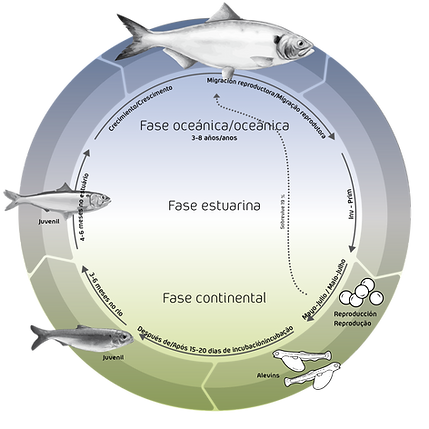
the shad
alose alose (Linnaeus, 1758)
Order: Clupeiformes
Family:Clupeidae
save
sábalo, saber, zamborca
Allis Shad
Species anadromous, pelagic y euryhaline. It spends most of its life cycle in the sea and can reach a maximum age of 10 years. The adults enter the Miño river in February and finish the breeding period in August.
Morphology
Body elongated and compressed laterally with rounded scales. The mandible reaches the posterior edge of the eye. There are no teeth on the vomer. The dorsal fin is short and the eye has a sheath. It is distinguished by silver coloration, large scales and small fins. The spinal column is made up of a set of 57 to 58 vertebrae. The dorsal fin has 19-21 rays (4-6 hard; 13-18 soft) and the anal fin 21-24 rays (3-4 hard; 18-21 soft). It is bluish-green to gray on the back and silvery on the belly. It has a black spot near the upper edge of the opercular opening.
The similar species issaboga (alosa fallax)which can be distinguished by the number of lateral line scales and the number of gill spines. Tarpon have more than 70 lateral line scales and between 80-130 gill spines.
The length varies between 35-40 cm and can reach 80 cm. The females can reach 6 Kg in weight, but rarely exceed 4 Kg. The average weight of the specimens captured in the Minho River is around 2.7 Kg, with 5 Kg.

Adulto

Adulto

Juveniles/juvenís

Adulto
biology
anadromous species(migrates from the sea to the river), pelagic and euryhaline. Enters rivers in spring. Before the existence of dams, and in the longest rivers,the tarpon migrated more than 700 km to lay eggs.Although some may return to the sea after breeding, most are believed to die before reaching the sea.There is evidence showing that the tarpon breeds in the river where it was born.
The sábalo only reproduces in the main course of the Miño River, without entering the tributaries. Reproduction takes place in May, June or July and the breeders, when they enter the Miño, are between 3 and 9 years old. In general, females are older and larger. Depending on the weight, they can produce between 100,000 and 600,000 eggs. Normally these eggs are laid on gravel bottoms, in well-oxygenated waters, at depths less than 1.5 meters.
The juveniles, when they reach about 10 cm (following autumn) migrate to the sea and grow feeding on planktonic crustaceans. From adults it feeds on small crustaceans, fish and algae. When they enter fresh water they stop eating.

Distribution
Tarpon is distributed from Iceland to the Atlantic coast of Morocco. Its presence in certain areas is sporadic, such as Scandinavia (Norway, Sweden and Finland), as well as in the British Isles.
Tarpon populations are generally declining, as is the case in Germany and Belgium. In France, it disappeared from the Seine and Vilaine rivers. However, they are abundant in the Loire, Garonne, Dordogne and Adour rivers.
In Portugal, they enter the Miño, Lima, Mondego, Tejo, Sado and Guadiana rivers. It happens, still on the Spanish and French coast of the Mediterranean. Its available habitat in the Miño river basin only reaches the Frieira dam.
Conservation
Species indigenous. The population reduction was evident after the construction of the Miño River dams. Sensitive to declining water quality and habitat change.
-Red Book of Vertebrates of Spain: (V) Vulnerable
-Livro Vermelho dos Vertebrados de Portugal: (EN) Em perigo
Fishing
The sábalo, in the Minho river basin, is a species of great commercial and cultural importance, being considered asthe emblematic fish of the Miño river. Its exploitation is of great economic interest for the fishing communities, as well as for the population in general, due to its socioeconomic value, history, ethnography and gastronomy.
It is referenced in a very special way, both in the Portuguese and Galician margins. When abundant, it was the basic subsistence species that fed the fishing community and provided economic support. The fishermen's wives would sell the tarpon door to door, arriving at the end of the day with only the smallest parts of the fish: the head, tail fin area, and roe. To take advantage of what was left, they invented the now traditional "Debulho de Sável".
The known official records on the capture of tarpon began in 1914. The highest value recorded by Portuguese fishermen was in 1925 and 1939, with 115,000 individuals. From 1976, the record ceased to in number of specimens captured to be made in weight. Between 1980 and 2004, the maximum value was in 1980, with 18,000 kg and the minimum in 1988, with 300 kg. In 2004, Portuguese fishermen declared values in the order of 6,000 Kg.
The decrease in the amount of sábalo is associated with the progressive construction of dams on the Minho River.

Official values of tarpon fishing declared by Portuguese fishermen, from 1914 to 2011. Source: Capitania do porto de Caminha
Fishing arts:
-
Between the southern part of the islands of Verdoejo (Monção) and the sea:tresmallo between March and June. Elaljerifit was used in this area in the old days, but fell out of use when the amount of tarpon dropped sharply_cc781905-5cde-3194-bb3b-136bad5cf58d.
Throughout the stretch internacional, sport fishermen can fish with rods and lines between March and June.